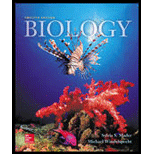
Concept explainers
To determine:
The potential consequences if honeybees were to go extinct.
Introduction:
Coevolution is a process in which one species undergoes modifications in its structure in response to the other species that have adapted itself; thus, both species are finally fit for each other. The best example of coevolution is bees and flowering plant that must contain colorful flowers that causes accommodation of bees.
Explanation of Solution
About 20,000 species of bees work as a pollinator for plants. Honeybees are the best-known pollinator onto the Earth. There are many plants and flowers that are mostly dependent on bees for pollination. Honeybee’s eyes are capable to see ultraviolet wavelengths; hence bees-pollinated flowers are bright in color. These flowers contain nectar guides that have ultraviolet shedding where a reproductive portion is present.
Humans are unable to detect ultraviolet rays; but bees can easily detect these rays, and are sensitive to these rays. Bees have proboscis that help them to feed nectar from several flowers and pollen tubes by their hinge legs. There are many plants and flowers that are mostly dependent on bees for pollination. Thus, this is a major concern that the number of honeybees were go to extinct. Human activities such as the use of herbicides and pesticides cause death of honeybees; some diseases are also responsible for their extinction.
Therefore, extinction of honeybees leads to the decline of various plants and flowering species that are dependent on honeybees for pollination. Due to the extinction of bees, pollination will get disrupt that will cause disruption in the propagation of many species of plants.
Coevolution gives opportunities to flowering plants to attract pollinators to produce many seeds. Plants and their pollinators undergo adaptations and modification to one another.
Want to see more full solutions like this?
Chapter 27 Solutions
Biology
- What is behavioral adaptarrow_forward22. Which of the following mutant proteins is expected to have a dominant negative effect when over- expressed in normal cells? a. mutant PI3-kinase that lacks the SH2 domain but retains the kinase function b. mutant Grb2 protein that cannot bind to RTK c. mutant RTK that lacks the extracellular domain d. mutant PDK that has the PH domain but lost the kinase function e. all of the abovearrow_forwardWhat is the label ?arrow_forward
- Can you described the image? Can you explain the question as well their answer and how to get to an answer to an problem like this?arrow_forwardglg 112 mid unit assignment Identifying melting processesarrow_forwardGive only the mode of inheritance consistent with all three pedigrees and only two reasons that support this, nothing more, (it shouldn't take too long)arrow_forward
- Oarrow_forwardDescribe the principle of homeostasis.arrow_forwardExplain how the hormones of the glands listed below travel around the body to target organs and tissues : Pituitary gland Hypothalamus Thyroid Parathyroid Adrenal Pineal Pancreas(islets of langerhans) Gonads (testes and ovaries) Placentaarrow_forward
 Human Anatomy & Physiology (11th Edition)BiologyISBN:9780134580999Author:Elaine N. Marieb, Katja N. HoehnPublisher:PEARSON
Human Anatomy & Physiology (11th Edition)BiologyISBN:9780134580999Author:Elaine N. Marieb, Katja N. HoehnPublisher:PEARSON Biology 2eBiologyISBN:9781947172517Author:Matthew Douglas, Jung Choi, Mary Ann ClarkPublisher:OpenStax
Biology 2eBiologyISBN:9781947172517Author:Matthew Douglas, Jung Choi, Mary Ann ClarkPublisher:OpenStax Anatomy & PhysiologyBiologyISBN:9781259398629Author:McKinley, Michael P., O'loughlin, Valerie Dean, Bidle, Theresa StouterPublisher:Mcgraw Hill Education,
Anatomy & PhysiologyBiologyISBN:9781259398629Author:McKinley, Michael P., O'loughlin, Valerie Dean, Bidle, Theresa StouterPublisher:Mcgraw Hill Education, Molecular Biology of the Cell (Sixth Edition)BiologyISBN:9780815344322Author:Bruce Alberts, Alexander D. Johnson, Julian Lewis, David Morgan, Martin Raff, Keith Roberts, Peter WalterPublisher:W. W. Norton & Company
Molecular Biology of the Cell (Sixth Edition)BiologyISBN:9780815344322Author:Bruce Alberts, Alexander D. Johnson, Julian Lewis, David Morgan, Martin Raff, Keith Roberts, Peter WalterPublisher:W. W. Norton & Company Laboratory Manual For Human Anatomy & PhysiologyBiologyISBN:9781260159363Author:Martin, Terry R., Prentice-craver, CynthiaPublisher:McGraw-Hill Publishing Co.
Laboratory Manual For Human Anatomy & PhysiologyBiologyISBN:9781260159363Author:Martin, Terry R., Prentice-craver, CynthiaPublisher:McGraw-Hill Publishing Co. Inquiry Into Life (16th Edition)BiologyISBN:9781260231700Author:Sylvia S. Mader, Michael WindelspechtPublisher:McGraw Hill Education
Inquiry Into Life (16th Edition)BiologyISBN:9781260231700Author:Sylvia S. Mader, Michael WindelspechtPublisher:McGraw Hill Education





